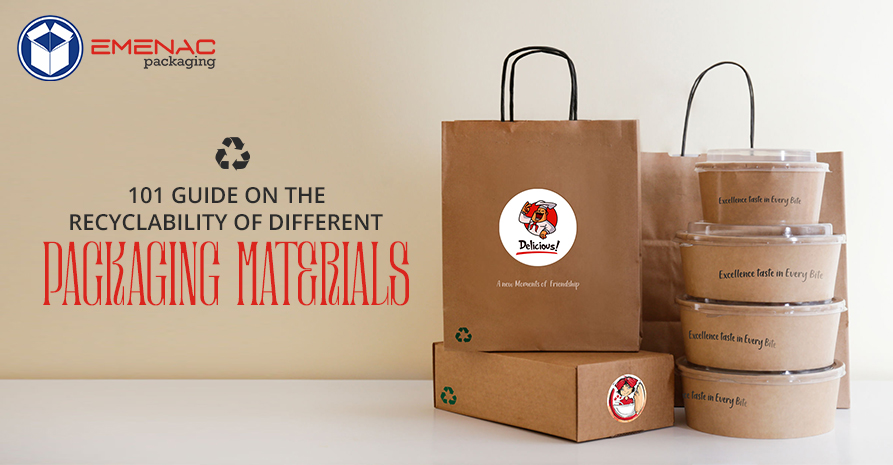
Are you worried about not having a cleaner tomorrow?
With a gradual rise in global warming, people all around the world prefer products that are more eco-friendly to play their part in sustaining the environment. Many companies around the globe are providing brands with amazing recyclable packaging materials.
Every year millions of tons of waste are produced by packaging. If people have the right way to dispose of their waste, it might help the company play its part in sustaining their environment. Custom packaging is a great initiative to incorporate custom materials in product packaging.
This allows brands to use eco-friendly and recyclable materials like cardboard, kraft, and materials with special coatings or laminations to be used. With all the specifications and features allowed via custom packaging. It is important brands are well-aware of how much every feature affects the recyclability of the packaging materials.
Every added element in the product packaging serves as an additional burden on the packaging recyclability of the products. Normal paper requires 2-3 weeks to degrade however, plastic takes up to 10,000 years and more to degrade or get some parts recycled.
To stop this, now your brand can play its part by using custom eco-friendly packaging such as custom cardboard boxes or custom kraft boxes.
These boxes are specially made to ensure 100% safety of products along with that of the environment. Jotting down the effect of features on different packaging recyclability, we may state the following;
Kraft paper directly originated from paper pulp and is highly used to make custom kraft boxes. These packaging boxes are made to keep your organic products safe and toxin-free. Any type of dust or allergen can not pass this packaging keeping your products safe to use.
Mostly, kraft custom boxes are used to pack food items or soaps. These products, as in direct contact with humans, have to be safe to use. These kraft custom boxes are 100% recyclable and can be readily used by a brand that wants to work on the “Go Green” initiative.
Custom kraft boxes are highly cost-effective and lightweight for brands to use. These boxes are also very easily printed but are preferred to be used as raw kraft boxes.
Coated packaging has a coating layer that is often made of polymer. The coating has the advantages of making your packaging glossier, smoother, and brighter, and protecting the printed ink.
Lamination is a kind of exterior coating that covers packaging with a thin layer of plastic to enhance the appearance and safeguard packaging design. Ink is sealed onto packaging using a form of coating called a water-based aqueous coating.
Although it is more affordable and environmentally friendly than lamination and offers a variety of finishes, lamination offers superior protection. Aqueous coating is more environmentally friendly than other types of varnish because it is water-based and can be recycled on its whole. UV coatings are another kind of recyclable coating. Hence, we may conclude that the custom cardboard boxes coated with lamination are comparatively hard to recycle due to the less eco-friendliness of laminated polymer.
If any brand likes to have its logo or brand tagline sprinted with ink on its custom packaging boxes, it will no doubt enhance its product presentation by many folds. But what causes a hindrance is the recyclability of packaging.
When additives like inks or foiling are added to the product packaging, it gets a little more difficult for the recycling agencies to recycle your product packaging. There are different types of printing ink used, petroleum ink being the most hazardous one of all along with being expensive.
These inks are less biodegradable as compared to soy-based inks that are comparatively organic and produce a bright and more eco-friendly ink texture. These soy-based inks are brighter than petroleum inks and are mixed with oils and resins to give a clearer finish.
Lastly, if we come to brands using product packaging that is made with already recycled cardboard or corrugated paper. This is no doubt an eco-friendlier approach but requires more manpower.
A lot of processes are required to separate an already used cardboard from its useable fibers and then to break down these boards to make a new packaging material.
These packaging materials can be prepared on the demand of any brand such as a custom packaging supplier who converts this used-up cardboard or corrugated boards into paper pulp and then remove their impurities chemically and mechanically.
After de-inking all sorts of ink, the final paper board is obtained as a long sheet of paper that can be sued for all types of purposes from writing paper to product packaging Brands can also send in their leftover cardboard packaging boxes for recycling if fewer features or additives are used for its embellishments.
In this guide, we explained how brands can easily incorporate certain additives and coatings with the knowledge of how much effect it puts on the recyclability of the product packaging.
Now brands can easily decide what they want as additional components in their packaging if they want to incorporate recyclable packaging.